
THE GASPE PENINSULA
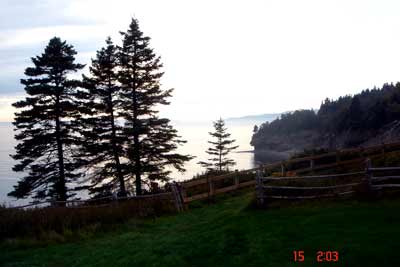 |
Gaspe |
|---|---|
 |
Getting to Land's End

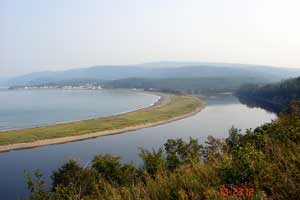 From Godbout to Matane, where our ferry crossed, the St. Lawrence river is 65km wide (about 40 miles). Even as far west as Montreal, the St. Lawrence makes our Western rivers look like streams. Even the mighty Columbia is no match for this famous waterway. The city of Matane, where we landed, is directly northeast from the tip of Maine, with New Brunswick in between. The coastline here is gently rolling forested hills and farmland, dotted with small fishing villages. The shrimp fishery is a major industry here, and it was a pleasure to eat delicious wild shrimp again. As we write this, we're parked on a beach outside Ste-Anne-des-Monts, which is just too lovely to leave. Last night, after a dinner of local seafood in a bustling restaurant, we returned to our camp, built a fire on the beach, then drifted off to sleep with the waves of the St. Lawrence lapping the shore.
From Godbout to Matane, where our ferry crossed, the St. Lawrence river is 65km wide (about 40 miles). Even as far west as Montreal, the St. Lawrence makes our Western rivers look like streams. Even the mighty Columbia is no match for this famous waterway. The city of Matane, where we landed, is directly northeast from the tip of Maine, with New Brunswick in between. The coastline here is gently rolling forested hills and farmland, dotted with small fishing villages. The shrimp fishery is a major industry here, and it was a pleasure to eat delicious wild shrimp again. As we write this, we're parked on a beach outside Ste-Anne-des-Monts, which is just too lovely to leave. Last night, after a dinner of local seafood in a bustling restaurant, we returned to our camp, built a fire on the beach, then drifted off to sleep with the waves of the St. Lawrence lapping the shore.
In the morning we were surprised to see Pierre and Zoey, a couple we'd met the day before, camped nearby. They are both in the film industry in Montreal, Zoey as a camera person, and Pierre as a prop designer, also with his own TV show, where he builds crazy things from scratch, suggested by viewers, such as a dog-washing machine in which his own Chocolate Lab was the subject. The show airs 10 times a week, making him a celebrity 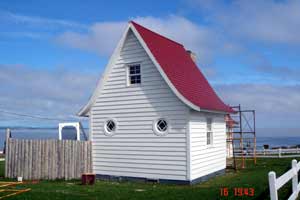 among the more rural Quebeqois (but no one he knows personally watches the show, he said). We noticed something about this couple that we've often seen in Canadian and European travelers, as well as in younger Americans: a deliberate choice to live modestly. This doesn't seem to be a factor of income, as many of those we've met have good careers; it seems more based on values, wanting to focus more on the basic pleasures of living. We like that.
among the more rural Quebeqois (but no one he knows personally watches the show, he said). We noticed something about this couple that we've often seen in Canadian and European travelers, as well as in younger Americans: a deliberate choice to live modestly. This doesn't seem to be a factor of income, as many of those we've met have good careers; it seems more based on values, wanting to focus more on the basic pleasures of living. We like that.
Le Parc
Driving east, the country grows more mountainous, the highway climbing then dropping into coves, most with tiny fishing villages, but some unsettled. We stopped at the Parc National Forillon, a national treasure at the eastern tip of the peninsula, where we were treated to wild seascapes and lots of porcupines. We asked a fellow what the French name for porcupine was, and he didn't know, maybe "raton-laveur" or something. Turned out he was Belgian, and had never before seen one. They have hedgehogs there. Ziggy had never seen one before, either, and she was screaming and yelling to get at it, which would have drastically changed our travel plans. We counted 7 porcupines in probably 24 hours. They're not afraid of people either, just go on munching grass and ambling slowly about like they own the place.
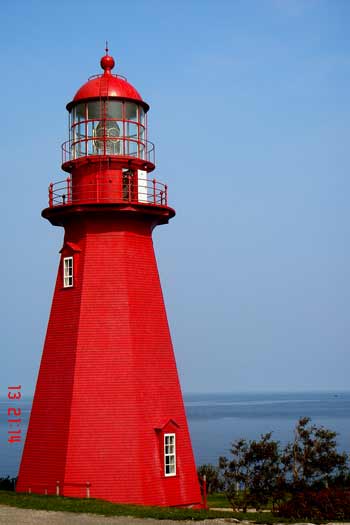 |
 |
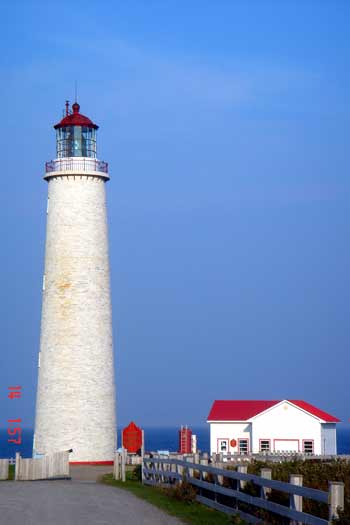 |
|---|
 |
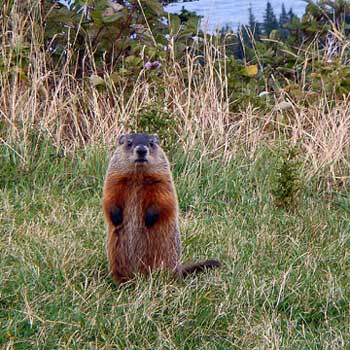 |
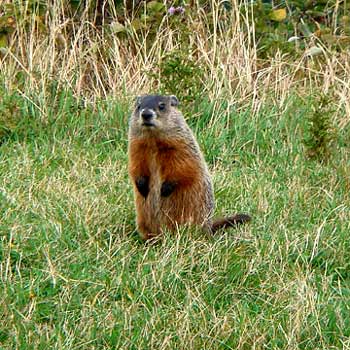 |
|---|
More scenes from Forrillon National Park
 |
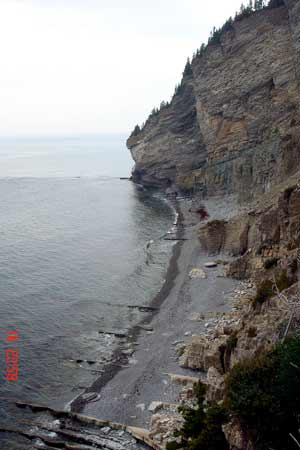 |
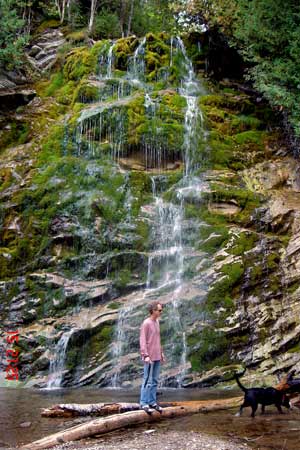 |
|---|---|---|
 |

Gaspe was famous for its cod fishery, which for nearly 300 years shipped dried and salted "Gaspe Cure" cod off to Spain, Italy, Brazil and Barbados, making fortunes for the mostly British owners, and barely a living for the fishermen. Why Spain and Italy? Being Catholic countries, people were obliged to eat fish over 100 days a year, and dried cod won't spoil. Why Brazil and Barbados? Inferior grades of cod found a market as food for the slaves on the large sugar plantations, and rum was the return cargo of choice. But by the 1970's, the Atlantic cod had had enough, and just gave out, like they did in St. George's Reef. People couldn't believe it; the cod seemed inexhaustible, like the sun and the rain. You can still buy Atlantic cod in Gaspe today, mostly shipped in from Greenland. It's a delicious fish eaten fresh, but only the most devout Catholic would eat it dried and salted (we tried).
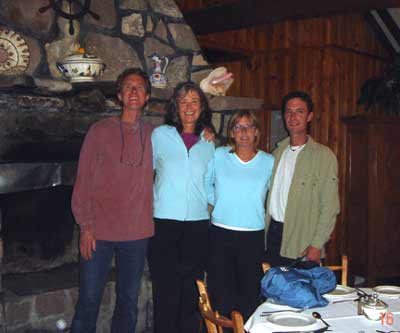 Taking a hike to the cape and lighthouse at the very tip of Forillon, we came to an overlook perched on the cliff, and met a couple with their two dogs. Having a dog is a great ice-breaker, we've found, at least to another dog owner, and we hung out there together for a couple of hours enjoying our conversation and the panoramic views of the rugged coastline where the St Lawrence finally joins the Atlantic. This couple, Stephan and Janice, from Pickering, near Toronto, were at the end of their vacation, and invited us to have dinner with them their last evening at a restaurant called La Gargantua, high on a hill above L'Anse-a-Beaufils (Son-in-law's Cove: some of these places sound a lot better if you don't know what they mean). Our timing was lucky; it was the last night before they closed for the season. The four of us had a wonderful evening together. La Gargantua lived up to it's name with huge quantities of good food, eaten slowly and in great company, we were the first to arrive and among the last to leave. We quickly became friends with Stephan and Janice, thankful that our dogs and our paths had brought us together. Awakening in our rig the next morning by the beach cottage they'd rented, we found a note from them, with a gift of some Canadian cds, Dave & Morley stories from the Vinyl Cafe, (a popular and funny CBC program), Guess Who, and Loreena McKennit. Pretty nice, eh? Thanks, guys! (we Californians call everyone "guys"- we're the leading edge of linguistic evolution).
Taking a hike to the cape and lighthouse at the very tip of Forillon, we came to an overlook perched on the cliff, and met a couple with their two dogs. Having a dog is a great ice-breaker, we've found, at least to another dog owner, and we hung out there together for a couple of hours enjoying our conversation and the panoramic views of the rugged coastline where the St Lawrence finally joins the Atlantic. This couple, Stephan and Janice, from Pickering, near Toronto, were at the end of their vacation, and invited us to have dinner with them their last evening at a restaurant called La Gargantua, high on a hill above L'Anse-a-Beaufils (Son-in-law's Cove: some of these places sound a lot better if you don't know what they mean). Our timing was lucky; it was the last night before they closed for the season. The four of us had a wonderful evening together. La Gargantua lived up to it's name with huge quantities of good food, eaten slowly and in great company, we were the first to arrive and among the last to leave. We quickly became friends with Stephan and Janice, thankful that our dogs and our paths had brought us together. Awakening in our rig the next morning by the beach cottage they'd rented, we found a note from them, with a gift of some Canadian cds, Dave & Morley stories from the Vinyl Cafe, (a popular and funny CBC program), Guess Who, and Loreena McKennit. Pretty nice, eh? Thanks, guys! (we Californians call everyone "guys"- we're the leading edge of linguistic evolution).
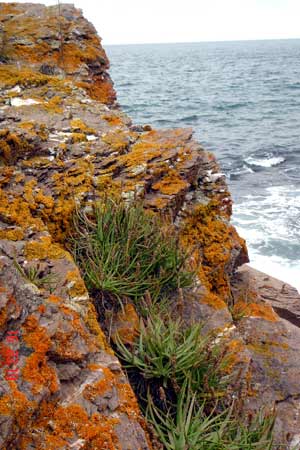 |
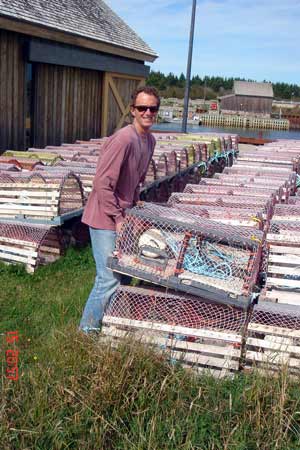 |
 |
|---|
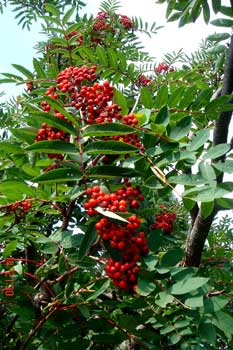
Stephan had told us about a farming co-op in the nearby inland village of Val d'Espoir (Valley of Hope), where we could get organic produce, so we searched them out and were delighted to find a well-run operation with lots of land in production, a small store, a large herb garden, and an interpretive center. It had the signs of some federal subsidies, especially the interpretive center, and if so, it's nice to see the government supporting the development of small farms and public awareness of healthy food.
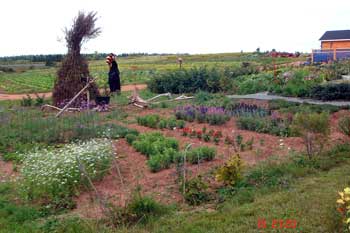 The interpretive center told the famous story, worth retelling, of a Saskatchewan wheat farmer named Percy Schmeisser, if memory serves, who was sued by the Monsanto Corporation because some of their patented GMO wheat was found growing in one of his fields. Turns out the wind had blown pollen from a neighbor's field into Percy's, who for 40 years had used his own seed, and had no interest in GMO wheat. Unfortunately for Percy, he didn't have the resources to defend himself against a giant like Monsanto. Since the company owned the patent, anyone in possession of the wheat without a without buying seed from Monsanto was guilty, no matter how it got there. It's enough to give huge multinational corporations a bad name!
The interpretive center told the famous story, worth retelling, of a Saskatchewan wheat farmer named Percy Schmeisser, if memory serves, who was sued by the Monsanto Corporation because some of their patented GMO wheat was found growing in one of his fields. Turns out the wind had blown pollen from a neighbor's field into Percy's, who for 40 years had used his own seed, and had no interest in GMO wheat. Unfortunately for Percy, he didn't have the resources to defend himself against a giant like Monsanto. Since the company owned the patent, anyone in possession of the wheat without a without buying seed from Monsanto was guilty, no matter how it got there. It's enough to give huge multinational corporations a bad name!
One of the gardens at Rocher Perce Coop, at right.

Where's the stick?
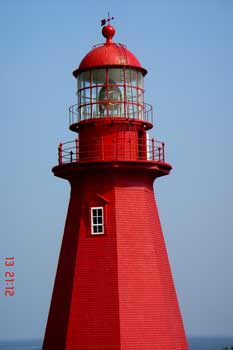
Travel Log, Past Entries: Click to read each one
Oregon, Washington June 2005
California July 2005
Southwest July/August 2005
Midwest August 2005
Northeast/August 2005
Ontario/August 2005
MontrealQuebec/August 2005